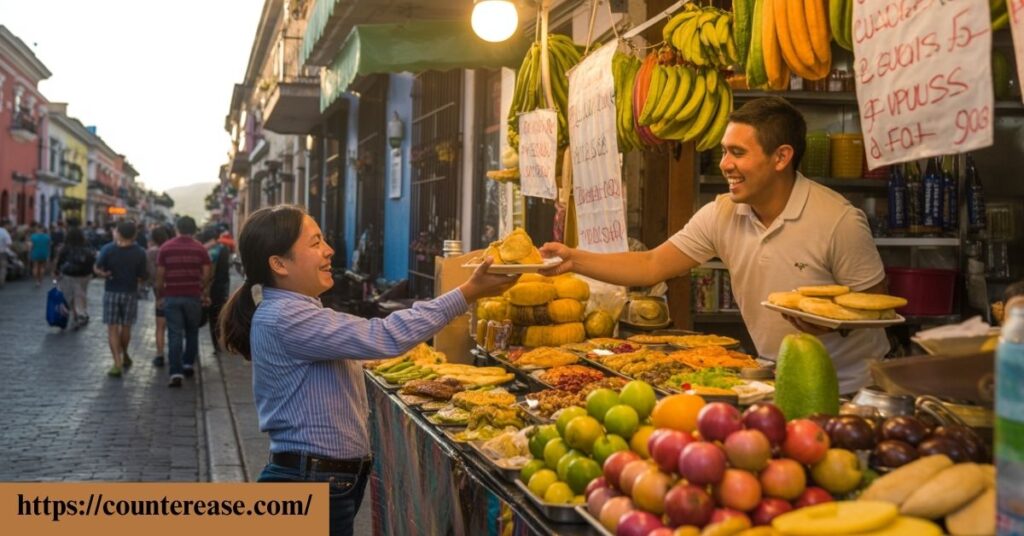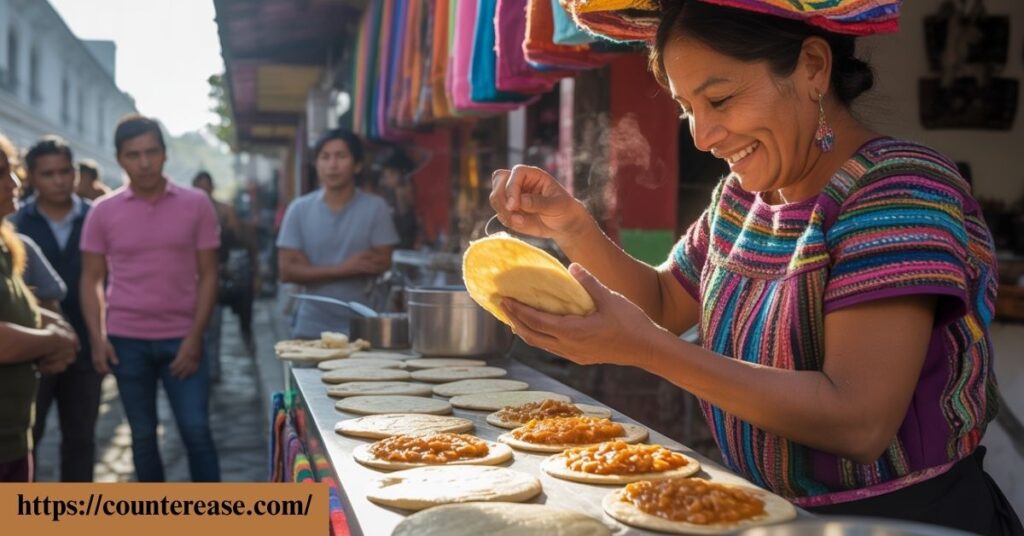A guide-to-guatemalan-street-food is a simple and helpful way to understand the local flavors, traditions, and must-try dishes found across Guatemala’s streets and markets. This guide to guatemalan street food gives travelers and food lovers clear insights into what to eat, where to find it, and how to enjoy it safely. From city stalls to village corners, this guide opens the door to a delicious part of Guatemalan culture that’s rich in history and taste.
The colors, smells, and sounds of Guatemalan street food are unforgettable. Vendors cook over open flames, serve steaming bowls of stew, and offer sweet treats wrapped in banana leaves. Every bite feels like a celebration of tradition. This guide to guatemalan street food vibrant food scene isn’t just a meal—it’s a cultural experience waiting to be tasted. If you love bold flavors and authentic moments, you’re in for something special.
With this guide-to-guatemalan-street-food, you’ll learn how to enjoy popular dishes like tostadas, chuchitos, rellenitos, and atol like a local. It gives practical tips, highlights regional specialties, and helps you dive into Guatemala’s food scene with confidence. Whether you’re walking through Antigua or exploring a small mountain town, this guide is your perfect companion to savoring street food the right way.
Guatemala’s Street Food Scene Will Change How You Think About Central American Cuisine
Guatemala’s street food scene represents one of Central America’s best-kept culinary secrets. Unlike its more famous Mexican neighbor, Guatemalan cuisine has quietly developed a distinctive identity that blends ancient Mayan heritage with Spanish colonial influences and modern innovation.

The country’s food scene thrives on every corner. Vendors start before dawn, preparing corn-based snacks and traditional beverages. By evening, the streets fill with families gathering around tostadas stands and elotes carts.
Guatemala street food differs significantly from other Central American cuisines. While Mexican food emphasizes bold spices, Guatemalan street food focuses on subtle flavors and fresh ingredients. The Mayan traditions still influence modern cooking methods, creating dishes you won’t find anywhere else.
Street vendors don’t just sell food—they preserve culture. Each chuchito wrapper tells a story. Every atol recipe passes down through generations. This isn’t tourist food; it’s the heartbeat of Guatemalan culture.
See Also: An Honest Review of Madeira
Essential Guatemalan Street Foods You Can’t Miss
Morning Must-Haves
Guatemala’s mornings begin with corn-based snacks and warm beverages that fuel the entire day. Street vendors position themselves near bus stops and markets, knowing locals need quick, satisfying breakfast options.
Chuchitos represent Guatemala’s answer to tamales, but they’re distinctly different. These corn dough parcels contain seasoned pork or chicken, wrapped in corn husks and steamed until tender. Unlike Mexican tamales, chuchitos use a lighter masa and milder seasonings that highlight the fresh ingredients.
| Dish | Price Range | Best Time | Key Ingredients |
|---|---|---|---|
| Chuchitos | Q5-8 | 6 AM – 10 AM | Corn masa, pork, tomato salsa |
| Rellenitos de plátano | Q3-5 | 7 AM – 9 AM | Sweet plantains, black beans, sugar |
| Atol de elote | Q2-4 | 6 AM – 11 AM | Fresh corn, milk, cinnamon |
Rellenitos de plátano showcase Guatemala’s love for combining sweet and savory flavors. Vendors mash ripe plantains with black beans, form them into patties, then fry until golden. The result? A crispy exterior hiding creamy, slightly sweet filling.
Atol de elote warms hearts across Guatemala’s highlands. This creamy corn drink uses fresh kernels blended with milk and spices. Vendors serve it steaming hot in plastic cups, perfect for cool mountain mornings.
Midday Street Classics
Lunch brings Guatemala’s most substantial street offerings. Workers crowd around vendors selling hearty portions that sustain them through long afternoons.
Pupusas guatemaltecas differ from their Salvadoran cousins in subtle but important ways. Guatemalan versions use slightly thicker masa and different filling combinations. Popular varieties include beans and cheese, chicharrón, or loroco flowers.
Garnachas represent pure Guatemalan street food artistry. Vendors spread crispy, fried tortillas with guacamole, then pile on shredded beef or chicken. Fresh salsa and curtido (pickled vegetables) complete these handheld masterpieces.
Shucos demonstrate Guatemala’s creative adaptation of international foods. These aren’t ordinary hot dogs. Vendors stuff them into fresh bread rolls with guacamole, cabbage slaw, and various salsas. Some locations offer over twenty different topping combinations.
Evening Favorites
Guatemala’s evenings bring families together around street food stalls. The atmosphere becomes social, with vendors knowing regular customers by name.
Elotes locos (“wild corn”) lives up to its name. Vendors coat boiled corn with mayonnaise, cheese, chili powder, and lime juice. Some stalls offer additional toppings like bacon bits or hot sauce varieties.
Tostadas guatemaltecas require serious construction skills. Vendors layer crispy tortillas with beans, shredded meat, cabbage, tomatoes, and multiple salsas. Eating them without making a mess becomes an art form.
Tamales colorados appear during special occasions and weekends. These red tamales get their color from achiote and chillies. The filling typically includes chicken or pork in rich, mildly spiced sauce.
Regional Street Food Specialties That Define Each Area
Antigua Guatemala
Antigua’s colonial streets host vendors who’ve perfected their recipes over decades. The tourism hasn’t diluted authenticity—locals still frequent the same stalls their grandparents visited.
Weekends transform Antigua’s markets into food tour destinations. Vendors specialize in sweet treats made from recipes dating back centuries. Former convent kitchens still produce traditional candies sold by street vendors throughout the city.
The Guatemala City food scene contrasts sharply with Antigua’s traditional approach. Modern food trucks serve fusion creations while maintaining Guatemalan roots.
Guatemala City’s Food Truck Revolution
Guatemala City embraces innovation while respecting tradition. Food trucks park in business districts, serving updated versions of classic street food staples.
Night markets operate in residential neighborhoods where locals gather after work. These locations offer the most authentic experiences, far from tourist areas. Vendors here focus on feeding families, not impressing visitors.
Hidden gems exist throughout the city’s zones. Zone 1’s street food reflects working-class preferences—hearty portions at low prices. Zone 10’s vendors cater to office workers seeking quick, quality lunches.
Quetzaltenango (Xela)
Xela’s indigenous heritage influences its street food more than anywhere else. Mayan traditions remain strong here, affecting ingredients, preparation methods, and serving customs.
Market days bring special food offerings. Vendors prepare dishes rarely seen elsewhere, using ingredients grown in surrounding highlands. Cold-weather comfort foods dominate menus during cooler months.
Traditional beverages here include atol varieties found nowhere else. Some vendors offer atol made from purple corn, others use amaranth or quinoa.
Lake Atitlán Villages
Lakeside towns each maintain distinct food traditions. Santiago Atitlán vendors specialize in fresh ingredients from the lake, while Panajachel offers more diverse options.
Tourist areas present challenges for authentic street food hunters. However, villages like San Juan La Laguna and Santa Cruz preserve traditional cooking methods unchanged for generations.
Seafood preparations here use techniques predating Spanish colonization. Some vendors still cook in clay pots over wood fires, creating flavors impossible to replicate with modern equipment.
See Also: Review: Discover Airlines A330-300 Business Class Windhoek-Frankfurt
Caribbean Coast (Livingston)
Livingston’s Garifuna cultural influences create Guatemala’s most unique street food experience. Coconut features in both savory and sweet preparations.
Seafood dominates street offerings here. Vendors prepare whole fish grilled over coconut husks, creating distinctive smoky flavors. Fresh produce includes fruits and vegetables unknown in Guatemala’s highlands.
The cultural blend extends to beverages. Vendors serve drinks combining Mayan, African, and Caribbean influences—combinations you won’t taste elsewhere.
Sweet Street Treats That Define Guatemalan Dessert Culture
Guatemala’s sweet treats reflect the country’s complex cultural heritage. Mayan honey traditions merge with Spanish sugar techniques and modern innovations.
Molletes vary by region but always satisfy sweet cravings. These sweet breads come stuffed with cream, fruit preserves, or beans (surprisingly delicious). Vendors often toast them fresh when you order.
Dulce de leche guatemalteco differs from Argentine versions through local preparation methods. Guatemalan vendors add cinnamon and vanilla, creating more complex flavors.
Street vendors prepare mazapán fresh daily using local almonds. The texture remains softer than commercial versions, often shaped into flowers or animals.
Cocadas use fresh coconut from Guatemala’s Pacific Coast. Vendors grate coconuts by hand, ensuring optimal texture and flavor.
Pro Tips for Street Food Success in Guatemala

Safety Without Paranoia
Street food safety requires common sense, not fear. Busy vendors turn over ingredients quickly, ensuring freshness. Empty stalls suggest food sits too long.
Peak eating times vary by food type. Breakfast vendors work hardest between 6-9 AM. Lunch crowds peak around noon. Evening stalls get busy after 5 PM.
Learning basic Spanish phrases helps tremendously:
- “¿Qué me recomienda?” (What do you recommend?)
- “¿Está fresco?” (Is it fresh?)
- “Sin picante, por favor” (No spicy, please)
Cultural Etiquette
Guatemalan vendors appreciate polite customers who don’t rush orders. Most prepare food to order, requiring patience.
Tipping isn’t expected but rounding up to the nearest quetzal shows appreciation. For exceptional service or especially good food, adding Q1-2 makes vendors’ day.
Eating with hands is acceptable for most street foods. Vendors provide napkins or tissues. Some offer plastic utensils for messier dishes.
Money Matters
Street food remains incredibly affordable. Most items cost Q2-8 (roughly $0.25-1.00). Bringing small bills prevents awkward change situations.
Bargaining rarely applies to street food prices. Posted prices are typically final. However, buying multiple items sometimes earns small discounts.
Insider’s Guide to Finding Authentic Street Food
Timing Strategies
Guatemala’s street food follows predictable schedules. Understanding timing helps you catch vendors at their best.
Seasonal specialties appear throughout the year:
- Tamales colorados during holidays
- Fresh fruit varieties following harvest seasons
- Special sweet treats during religious festivals
Festival times bring unique food opportunities. Vendors prepare dishes only during specific celebrations, offering tastes unavailable year-round.
Location Intelligence
University areas offer budget-friendly options with generous portions. Students demand value, so vendors respond with hearty servings.
Business districts cater to office workers needing quick lunches. Quality remains high but portions might be smaller than residential areas.
Residential neighborhoods provide the most authentic experiences. Vendors here serve families and longtime customers, maintaining traditional recipes.
Vendor Selection Wisdom
Quality indicators include:
- Fresh ingredients visible during preparation
- Steady customer flow throughout service hours
- Clean preparation areas and serving utensils
- Vendors who taste their own food while cooking
Local customer patterns reveal the best stalls. If Guatemalans line up regularly, the food’s worth trying.
Building relationships with regular vendors improves your experience. They’ll remember your preferences and might offer tastes of new items.
Common Street Food Questions Answered

Dietary Considerations
Vegetarian street food options exist but require careful selection. Many bean-based dishes contain lard. Corn-based snacks often prove safest for vegetarians.
Vegan options include:
- Plain elotes without cheese or mayonnaise
- Fruit-based atol varieties
- Grilled corn with lime and salt only
- Fresh fruit preparations
Gluten-free possibilities center around corn-based items. However, cross-contamination occurs frequently, so severe sensitivities require extra caution.
Practical Concerns
Water and ice safety varies by vendor. Bottled water vendors pose minimal risk. Ice from unknown sources requires more caution, especially in remote areas.
Bathroom access becomes crucial during food tours. Most markets have facilities, but carrying tissue paper helps since supplies aren’t guaranteed.
See Also: The Safest and Most Dangerous Cities in Central America
Mild stomach upset affects some visitors initially. This usually reflects dietary changes rather than food poisoning. Staying hydrated and eating smaller portions helps adjustment.
Street Food’s Cultural Significance
Guatemala’s street food represents more than convenient meals. These vendors support entire families while preserving culinary traditions spanning centuries.
Economic impact extends beyond individual sales. Street food vendors often source ingredients from small farmers, creating economic networks throughout rural Guatemala.
Social gathering aspects make street food central to community life. Vendors know their customers’ families, creating informal social centers throughout cities and towns.
Traditional cooking methods survive through street food vendors. Techniques lost in modern kitchens continue on street corners, preserving Guatemala’s culinary heritage.
Planning Your Guatemalan Street Food Journey
Food tourism in Guatemala requires strategic planning. Different regions offer distinct experiences, making comprehensive exploration worthwhile.
Recommended duration for serious food exploration spans 2-3 weeks. This allows time to visit major regions while building relationships with vendors.
Best months for food tourism run March through May and September through November. Weather remains pleasant while avoiding peak tourist seasons.
Combining street food with other cultural activities enhances the overall experience. Markets, festivals, and cooking classes complement street food adventures perfectly.
Guatemala’s street food scene offers adventures for every palate and budget. From highland tamales to coastal seafood, each region contributes unique flavors to this remarkable culinary landscape. The key lies in approaching with curiosity, respect, and appetite for authentic experiences that connect you directly with Guatemala’s vibrant culture and generous people.
FAQs
What should I avoid eating or drinking to stay safe?
Always avoid tap water, ice cubes, and raw fruits or vegetables that aren’t peeled—stick to bottled water and hot, well-cooked food.
Are street food vendors generally clean and safe?
Yes, they are usually fine. Still, choose vendors preparing food fresh and avoid stalls with food sitting out for long or visible flies.
What are some must-try Guatemalan street dishes?
Favorite choices include Pepián (a rich meat stew), Rellenitos de plátano, Tostadas, Pupusas, Tamales, Elote, and Buñuelos.
Is street food risky for health?
Gastro issues are common if food safety isn’t observed. To stay well, carry rehydration salts and eat at busy, clean places to avoid trouble.
Should I carry cash when buying street food?
Yes—vendors rarely accept cards, so keep small bills or Quetzals handy, especially at local markets and food stalls.
See Also: The Guatemalan Quetzal: A Guide to Money in Guatemala
Conclusion
Guatemalan street food is full of flavor, history, and culture. From crispy tostadas to sweet rellenitos, every bite tells a story. This guide-to-guatemalan-street-food helps you know what to eat and where to find the best local dishes. Whether you’re in a busy market or a small village, you’ll enjoy warm, homemade food at low prices. Trying street food is one of the best ways to connect with the people and traditions of Guatemala.
Use this guide-to-guatemalan-street-food to explore dishes safely and enjoyably. Follow local tips, look for clean vendors, and don’t be afraid to try something new. These street foods are not only tasty—they show the heart of Guatemalan life. With this guide, you’ll feel more confident as you eat your way through the country. Get ready for delicious flavors and unforgettable experiences on every corner.

Asia Jenni is a passionate travel writer and expert author on CounterEase.com. With a deep love for exploration, she shares insightful travel guides, tips, and destination recommendations, helping travelers discover new places with ease. Her expertise in curating memorable trips and her engaging writing style make her a valuable resource for anyone looking to plan their next adventure.








